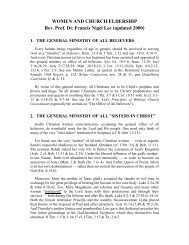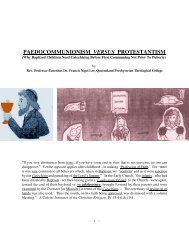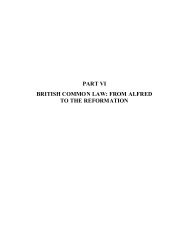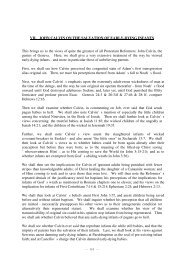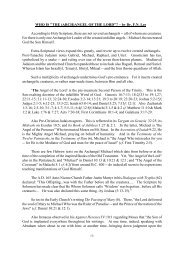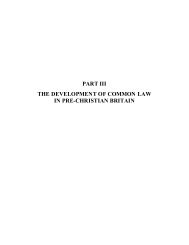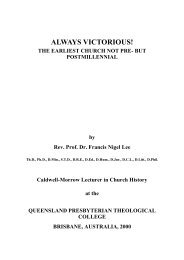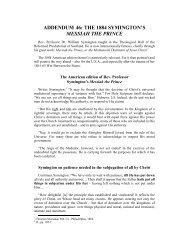Ethiopian eunuch had learned about Christ from Philip, and the decadent hybridised form <strong>of</strong>syncretism between Paganism and Judaism that had been in Ethiopia from after the time <strong>of</strong> KingSolomon onward.Last, we encounter in the book <strong>of</strong> Zephaniah chapter three a prediction about a people beyond therivers <strong>of</strong> Ethiopia who would one day bring an <strong>of</strong>fering <strong>of</strong> pure lips unto Jehovah. <strong>The</strong>re is a school<strong>of</strong> thought, especially in South Africa and Rhodesia (now named Zimbabwe), that this is areference to the White Christian civilisation which would be planted in 1652 and thereafter -- at thesouthern tip <strong>of</strong> Africa, beyond the rivers <strong>of</strong> Ethiopia. From then on, these people would bring asacrifice <strong>of</strong> pure lips -- the pure preaching <strong>of</strong> the gospel and <strong>of</strong> everything they have, to Jehovah.I do attach some credence to this interesting idea. After all, the Old Testament records over andover again that all the ends <strong>of</strong> the world shall turn to the Lord -- even Tarshish or Spain, and Javanor the Greeks. Why then should it not also record that the southern tip <strong>of</strong> Africa too, beyond therivers <strong>of</strong> Ethiopia, will turn to God?With that, we enter the phase <strong>of</strong> early church history. In Africa, Jesus Himself, like Moses beforeHim, lived in Egypt as a boy (Matthew 2:13-21). Elsewhere too in the New Testament, we read <strong>of</strong>people like Simon <strong>of</strong> Cyrene in North Africa, who carried the cross <strong>of</strong> Jesus (Matthew 27:32). <strong>The</strong>nthere was Apollos. He was trained in Alexandria. Living in what is now Egypt in Africa, he wasexposed especially to the Septuagint -- the Greek translation <strong>of</strong> the Old Testament, originating thereabout 270 BC. He was mighty in the Scriptures, and helped evangelise both Ephesus and Greece(Acts 18:24f).<strong>The</strong>re was. also the case <strong>of</strong> Simon called Niger. This means Simon the Black. He seems to havebeen one <strong>of</strong> the Prophets or Elders in the church <strong>of</strong> Antioch in Syria. Probably <strong>of</strong> African origin, itwould certainly seem he was a dark-skinned man. He was apparently a Member <strong>of</strong> the Presbyterywhich set aside Paul and Barnabas for their first missionary journey unto the work to which theHoly Spirit had called them first in Cyprus and then in what is now southern Turkey. Indeed,Lucius <strong>of</strong> Cyrene was yet another African in that Syrian Presbytery. Acts 13:lf.So then, there is far more in the Bible about Africa -- than there is about America, North or South;and certainly more than there is about Australia!In the history <strong>of</strong> the Early Church we also find that Africans feature quite prominently in thesubsequent post-canonical development <strong>of</strong> theology. <strong>The</strong>re is Clement <strong>of</strong> Alexandria in Egypt, agreat librarian and a man <strong>of</strong> massive intellect. After him, a little further to the west in North Africa,there was the great Tertullian -- the man who invented the term "Trinity"; perhaps apostmillenialist; and a man <strong>of</strong> great intellectual depth. <strong>The</strong>re were also several lesser leaders inAfrica, such as Nepos and Julianus Africanus.Among the more major figures, was Origen in Egypt. He was the first theologian now conceded byall millennial parties definitely to have been a postmillenialist. He was a man <strong>of</strong> tremendousintellect, who wore out seven secretaries while dictating to them all <strong>of</strong> his books. Finally, havingsacrificed his life to writing or dictating through secretaries -- tragically, all <strong>of</strong> his works weredestroyed in the fire at the great library in Alexandria.Later, in the western portion <strong>of</strong> North Africa, we discover perhaps the greatest theologian <strong>of</strong> alltime and certainly <strong>of</strong> the first millennium <strong>of</strong> Christianity -- the great African Augustine <strong>of</strong> Hippo.He is regarded by both Roman Catholics and Protestants as being unquestionably the greatesttheologian <strong>of</strong> all time to which they both appeal as being authoritative. Maybe Calvin was a littlemore important for Protestants. Maybe Thomas Aquinas was a little more important to Catholics.
But the only one they both appeal to and agree was fundamentally important, was Augustine <strong>of</strong>Hippo.So what you have in Africa in these early Christian centuries -- in Northeast Africa (in Egypt), andin Northwest Africa in Carthage (in what is now Tunisia and Algeria), and also further down inNortheast Africa at Ethiopia -- is the development <strong>of</strong> three pretty solid Christian centres.Sad to relate, however, from 620 AD onward, Mohammed almost totally destroyed all <strong>of</strong> theChristianity that had been built up in Africa. He sent his armies forth from Arabia throughoutEgypt, cutting down and destroying and forcibly threatening the Christians there. Only the mosthardy ones held on to the Christian faith. <strong>The</strong>y were terribly discriminated against, and lost theirpositions <strong>of</strong> power. Those Moslems gravely ravaged Christianity in Egypt. <strong>The</strong>y totally annihilatedthe Christian communities in Northwest Africa, which had been perhaps the strongest Christiancommunities in the world at that time. Mercifully, Islam did not at that stage make any dentwhatsoever into what is now Ethiopia -- although in subsequent centuries, the process <strong>of</strong> the spread<strong>of</strong> Mohammedanism even into that area began to increase.It was a catastrophe for the Christian churches, to be decimated in their greatest strongholds inNortheast and Northwest Africa. But Christianity does not die easily. God had begun the <strong>of</strong> Africain the north. After this temporary setback, He would later begin its re-christianisation. But thistime, from the south and through the agency not <strong>of</strong> Semites but <strong>of</strong> Japhethites - Caucasian children<strong>of</strong> Japheth who would arrive there round about 1650.Meantime, Islam consolidated its hold over the whole <strong>of</strong> North Africa. It filtered down reasonablyfast, through the Nile Valley. If surrounded Ethiopia, as a semi-Christian preserve <strong>of</strong> a veryritualistic nature. It cut Ethiopia <strong>of</strong>f from influencing other areas in Africa as Islam movedsouthward throughout what is now Kenya and Uganda (converting many Black pagans to Islam inits wake).At a slower rate, Islam seems to have filtered southward also from Northwest Africa -- right acrossthe Sahara desert by way <strong>of</strong> the caravan trains travelling into the north <strong>of</strong> what is now Mali andNigeria. It then converted to Islam not merely Semites but Hamites -- non-Arab Black people orNegroes. <strong>The</strong>y then developed rather strong Negro Moslem Governments in what is now thesouthern edge <strong>of</strong> the Sahara desert in West Africa. From there, they moved down at a somewhatslower pace throughout areas such as Chad, Equatorial Africa, and (very marginally) through theCongo.<strong>The</strong>y did not then, however, move any farther south <strong>of</strong> that area. Yet they made a further push,perhaps in the fifteenth and sixteenth centuries -- through Uganda into Tanzania. <strong>The</strong>re, theMoslem towns <strong>of</strong> Mombasa and Dar-es-Salaam were established. Dar-es-Salaam, one <strong>of</strong> the chieftowns in what is today Tanzania, is an Arabic name meaning "the Place (or the stronghold) <strong>of</strong>Islam."That is indeed just what it became. Indeed, <strong>of</strong>f the coast lay Zanzibar -- the island where ArabicMoslem slave-traders used to come with their slave-ships, down the eastern coast <strong>of</strong> Africa. <strong>The</strong>yeither forcibly converted Black pagans to Islam, long before Whites got there -- or otherwise theycarried them <strong>of</strong>f into slavery. In that way, they introduced many Black people even into Arabia.This then is the picture we have <strong>of</strong> Africa, just before the Whites went there to the extreme south.For there was a movement <strong>of</strong> Arabic Mohammedanism, especially in East Africa. It was headedsouthbound and was promoted not only by Arabs but also by Black Moslems. It was especiallypromoted by non-Black Arab slave-traders, as they moved on down through Tanzania into what is
- Page 1 and 2: THE CHRISTIAN AFRIKANERSA Brief His
- Page 3 and 4: God richly bless the following lect
- Page 5: There have always been, and always
- Page 9 and 10: Now Zuidema was a very great Dutch
- Page 11 and 12: Dutch churches at the Synod of Dord
- Page 13 and 14: station -- to help the Dutch ships
- Page 15 and 16: It is a country dedicated to freedo
- Page 17 and 18: 1760 -- there was more and more dis
- Page 19 and 20: with the Dutch. Many moved farther
- Page 21 and 22: said: "The British have placed our
- Page 23 and 24: financed by White money. It is buil
- Page 25 and 26: Famous Boer Generals, left to right
- Page 27 and 28: Three: Unannihilated: the Resurrect
- Page 29 and 30: (who had arrived in the country onl
- Page 31 and 32: of success.I may add that White Sou
- Page 33 and 34: General Beyers felt that those text
- Page 35 and 36: Balfour Declaration. The gist of it
- Page 37 and 38: Africa; treks on into the land both
- Page 39 and 40: Four: The Eschatology of Victory in
- Page 41 and 42: ide -- to use the instrumentality o
- Page 43 and 44: Christian National Calvinist Public
- Page 45 and 46: through constitutional process it h
- Page 47 and 48: I guess the best way to describe Sm
- Page 49 and 50: He was followed after his assassina
- Page 51 and 52: So the Scots came. I am going to sp
- Page 53 and 54: the Reformed Church in South Africa
- Page 55 and 56: ook on Hebrews. But his greatest wr
- Page 57 and 58:
At that point, Du Plessis enquired
- Page 59 and 60:
Yet quite apart from this high view
- Page 61 and 62:
One last point. There is a tremendo
- Page 63 and 64:
African Republic in 1902, the Cape
- Page 65 and 66:
One of the most important Calvinist
- Page 67 and 68:
Pellissier, who wrote on music and
- Page 69 and 70:
perspective -- even while he minist
- Page 71 and 72:
ever encountered by the Whites in S
- Page 73 and 74:
Now the United States does not need
- Page 75 and 76:
majority of the White citizens are
- Page 77 and 78:
Now you will not find in any of Sto
- Page 79 and 80:
Finally, Stoker argues that the so-
- Page 81 and 82:
This then brings Stoker to another
- Page 83 and 84:
This Brummer just referred to, is a
- Page 85 and 86:
Man was to rejoice in this nature (
- Page 87 and 88:
enhanced. For, in the present, man
- Page 89 and 90:
he declared, riddled with the ungod
- Page 91 and 92:
Van der Waal is a very brilliant So
- Page 93 and 94:
World War II when he was hiding fro
- Page 95 and 96:
The Professor of Philosophy -- or I
- Page 97 and 98:
glory.There are also Christian psyc
- Page 99 and 100:
Then there are Christian criminolog
- Page 101 and 102:
Massachusetts at Gordon- Conwell fo
- Page 103 and 104:
well known -- is being pioneered in
- Page 105 and 106:
people in South Africa. The South A
- Page 107 and 108:
nature and of human culture (Prover
- Page 109 and 110:
The parousia of Jesus Christ will i
- Page 111 and 112:
more and more christianised. Later
- Page 113:
END



